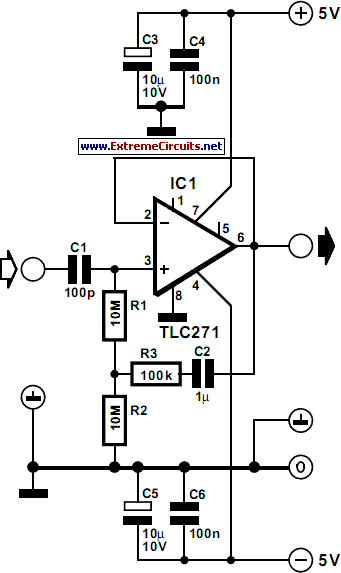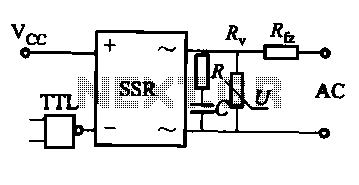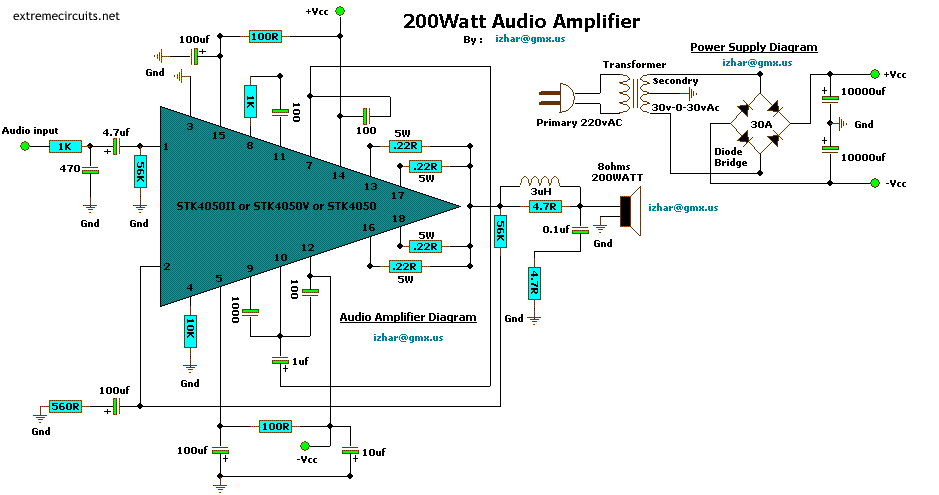
input impedance booster circuit

The input impedance of AC-coupled operational amplifier (op-amp) circuits is primarily determined by the resistance that establishes the DC operating point. When using CMOS op-amps, the input impedance is high, reaching up to 10 MΩ in current op-amps. For applications requiring an even higher input impedance, a bootstrap technique can be employed to artificially elevate the input impedance to a significantly higher level. In the provided circuit diagram, resistors R1 and R2 collectively form the resistance that sets the DC operating point for op-amp IC1. Without additional modifications, the input impedance would be approximately 20 MΩ. However, due to the feedback mechanism where part of the input signal is fed back in phase, the alternating current through R1 is reduced. The input impedance, Zin, can be calculated using the formula: Zin = (R2 + R3)/R3 * (R1 + R2). With the specified component values, Zin is approximately 1 GΩ, and the circuit draws a current of about 3 mA.
In this AC-coupled op-amp circuit, the input impedance is crucial for maintaining signal integrity and minimizing loading effects on the preceding stage. The choice of resistors R1 and R2 is essential as they not only set the DC operating point but also influence the overall gain and frequency response of the circuit. The feedback mechanism employed in this configuration allows for improved stability and linearity, which are vital for accurate signal amplification.
The bootstrap technique mentioned can involve additional components, such as capacitors and additional resistors, to create a feedback loop that enhances the input impedance further. This is particularly useful in high-impedance applications, such as sensor interfacing, where maintaining a high input impedance is necessary to avoid signal degradation.
In practical designs, careful consideration must be given to the selection of op-amps, as their input bias currents and noise characteristics can significantly impact performance. The specified current draw of approximately 3 mA indicates that the circuit is designed for low-power applications, making it suitable for battery-operated devices or energy-efficient systems.
Overall, the described circuit exemplifies the importance of input impedance in op-amp design and the methods used to achieve high values suitable for various applications in electronic systems.The input impedance of a. c. -coupled op amp circuits depends almost entirely on the resistance that sets the d. c. operating point. If CMOS op amps are used, the input is high, in current op amps up to 10 M. If a higher value is needed, a bootstrap may be used, which enables the input impedance to be boosted artificially to a very high value. In the diagram, resistors R1 plus R2 form the resistance that sets the d. c. operating point for opamp IC1. If no other actions were taken, the input impedance would be about 20M. However, part of the input signal is fed back in phase, so that the alternating current through R1 is smaller. The input impedance, Zin, is then: Zin=(R2+R3)/R3)(R1+R2). With component values as specified, Zin has a value of about 1G. The circuit draws a current of about 3mA. 🔗 External reference
In this AC-coupled op-amp circuit, the input impedance is crucial for maintaining signal integrity and minimizing loading effects on the preceding stage. The choice of resistors R1 and R2 is essential as they not only set the DC operating point but also influence the overall gain and frequency response of the circuit. The feedback mechanism employed in this configuration allows for improved stability and linearity, which are vital for accurate signal amplification.
The bootstrap technique mentioned can involve additional components, such as capacitors and additional resistors, to create a feedback loop that enhances the input impedance further. This is particularly useful in high-impedance applications, such as sensor interfacing, where maintaining a high input impedance is necessary to avoid signal degradation.
In practical designs, careful consideration must be given to the selection of op-amps, as their input bias currents and noise characteristics can significantly impact performance. The specified current draw of approximately 3 mA indicates that the circuit is designed for low-power applications, making it suitable for battery-operated devices or energy-efficient systems.
Overall, the described circuit exemplifies the importance of input impedance in op-amp design and the methods used to achieve high values suitable for various applications in electronic systems.The input impedance of a. c. -coupled op amp circuits depends almost entirely on the resistance that sets the d. c. operating point. If CMOS op amps are used, the input is high, in current op amps up to 10 M. If a higher value is needed, a bootstrap may be used, which enables the input impedance to be boosted artificially to a very high value. In the diagram, resistors R1 plus R2 form the resistance that sets the d. c. operating point for opamp IC1. If no other actions were taken, the input impedance would be about 20M. However, part of the input signal is fed back in phase, so that the alternating current through R1 is smaller. The input impedance, Zin, is then: Zin=(R2+R3)/R3)(R1+R2). With component values as specified, Zin has a value of about 1G. The circuit draws a current of about 3mA. 🔗 External reference





